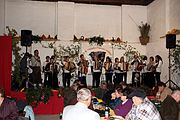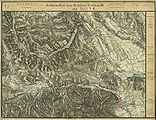Klostermarienberg
|
Klostermarienberg ( village ) locality cadastral community Klostermarienberg |
||
|---|---|---|
|
|
||
| Basic data | ||
| Pole. District , state | Oberpullendorf (OP), Burgenland | |
| Judicial district | Oberpullendorf | |
| Pole. local community | Mannersdorf an der Rabnitz | |
| Coordinates | 47 ° 25 '23 " N , 16 ° 33' 53" E | |
| height | 236 m above sea level A. | |
| Residents of the village | 330 (January 1, 2020) | |
| Building status | 183 (2001 ) | |
| Area d. KG | 7.72 km² | |
| Post Code | 7444 Mannersdorf | |
| Statistical identification | ||
| Locality code | 00199 | |
| Cadastral parish number | 33020 | |
| Counting district / district | Klostermarienberg (10811 005) | |
| Source: STAT : index of places ; BEV : GEONAM ; GIS-Bgld | ||
Klostermarienberg (until 1894 Klastrom, Hungarian: Borsmonostor) is a district in the municipality of Mannersdorf an der Rabnitz in Burgenland in Austria , which was named after the Marienberg monastery .
history
The first traces of settlement go back to the Stone Age .
Finds from the late La Tène period (190 BC until the birth of Christ) were located on the northern bank of the Rabnitz , about 400 m northeast of the village . Excavations carried out by the Landesmuseum Burgenland from 1972 to 1975 revealed silver coins, ceramics, a glass bead and large quantities of iron slag and roasted ore. Several dome stoves of the "deep Burgenland racing furnace " type were uncovered, one of which is on display in the Landesmuseum. The finds are in the last decades BC. To date. A Roman tombstone comes from a later period .
The 1197 by Dominik Bors , the Banus of Slavonia , due to a vow at a crusade founded Cistercian Abbey Marie Berg was a daughter house of Heiligenkreuz from the Filiation of Mori moon . It was damaged for the first time around 1240 and again around 1440. In 1532 it was destroyed during the Turkish invasions and soon after it was abandoned by the monks. The abbey was subsequently used as a quarry.
In 1680 the Marienberg monastery was rebuilt by Cistercian monks from Lilienfeld on behalf of Abbot Matthäus Kolweiß and was a provost's office until 1865; up to three confreres were stationed there. The parish church of Klostermarienberg and the provost's office were rebuilt between 1741 and 1780, with the remains of the medieval building in the cloister . The parish is still looked after by the Lilienfeld Abbey. The pastor has the official title of superior.
On March 29, 1945, the Red Army in the Klostermarienberg area penetrated Austrian territory (then German Reich territory) for the first time.
The village of Klostermarienberg is also known for its fruit growing. There are extensive apple and peach plantations around the place . Every year there is a chestnut festival on October 26th, the Austrian national holiday .
The roasted sweet chestnuts are the focus
Marienberg Abbey (far right) around 1880 (recording sheet of the state survey )
Art in the monastery
Under the title "KiK - Art in the Monastery", the monastery also serves exhibitions and museum purposes.
Dog Museum
The monastery housed the European Dog Museum , which arose from the special exhibition "Man & Dog - A Relationship Story", which was shown in 2001 in Marienberg Monastery. However, it has been closed since 2014.
literature
- Ferenc Leontius Hervay: Repertorium Historicum Ordinis Cisterciensis in Hungaria (Bibliotheca Cisterciensis 7, Rome 1984), pp. 63-79.
- Peter Pfister (Ed.): "Monastery guides of all Cistercian monasteries in the German-speaking area", Strasbourg: Éditions du Signe, 2nd edition 1998, pp. 524-525, ISBN 2-87718-596-6 .
- Josef Littsteuer: Cistercians in Klostermarienberg, in: Yearbook of the Diocese of Eisenstadt (1968), pp. 119–122.
Web links
Individual evidence
- ^ Susanne Sievers / Otto Helmut Urban / Peter C. Ramsl: Lexicon for Celtic Archeology. A-K and L-Z ; Announcements of the prehistoric commission in the publishing house of the Austrian Academy of Sciences , Vienna 2012, ISBN 978-3-7001-6765-5 , p. 937.






